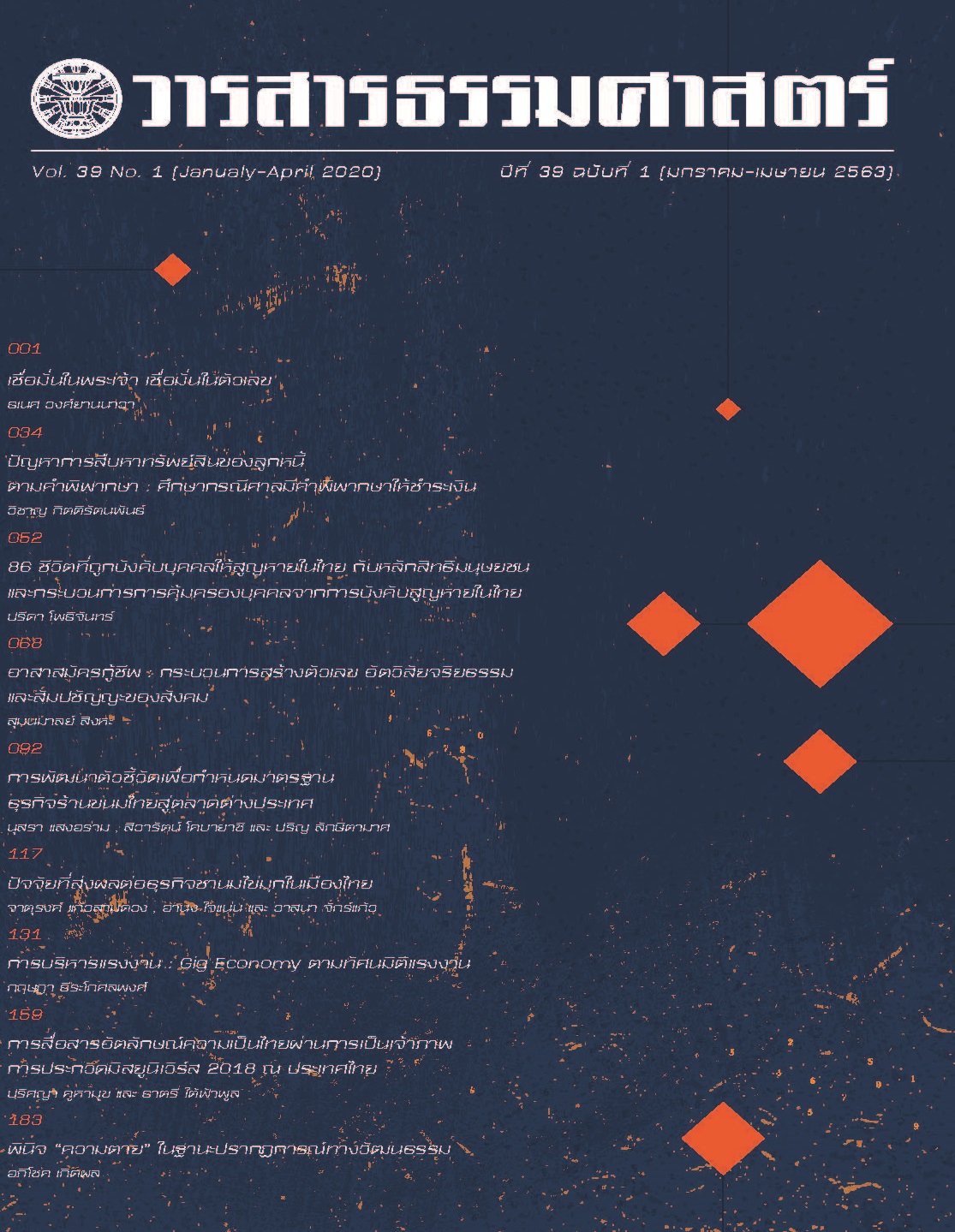Communicating Thainess Identity Through Hosting the Miss Universe Pageant 2018 in Thailand
Main Article Content
Abstract
This qualitative research intended to, first, study identities of Thainess channeled through Thailand as the host country to Miss Universe Pageant 2018. Second, to study Thai audience’s and foreign audience’s perception toward Thai identities. Researcher utilized content analysis to study the contest’s final round footage, an in-depth interview with the contest’s organizer as well as Thai
Identities experts, and document analysis to process documents from YouTube and Social Media. The results of this research shows that by hosting Miss Universe Pageant 2018, Thailand preferred to present its identities of Culture over Natural Resources by using 5 different means of communication; Videos, Performances, Background Graphics, Tangible Objects, and Personalities.
The communication of Thai identities was done in 2 manners, first, Traditional Thai Identities was presented through tourist attractions of Thai natural resources. Second, non-traditional Thai identities was presented through paying respect, Thai classical music, Thai dances, Muay Thai, the floating lamps tradition, garlands, Kranok patterns, Thai conventional architectures, Thai shoulder pieces. These representations of Thainess, however, belonged to the Thai royal tradition or the Great Tradition which was domestically celebrated. Thai audience perceived and conceived Thai identities better than foreign audience. Thai audience had diverse opinions on the presentation of Thai identities. The majority of Thai audience admired the way the presentation was done, the other group, however, took opposition. Those who opposed perceived the presentation of Thai identities as a depreciation of Thainess for instance; the use of Thai shoulder pieces with bikinis and the detail reduction of Kranok patterns used as graphics for the stage background.
Article Details
References
การท่องเที่ยวแห่งประเทศไทย. (2555). โครงการศึกษาภาพลักษณ์ด้านการท่องเที่ยวของประเทศไทยในสายตานักท่องเที่ยวต่างชาติ. กรุงเทพมหานคร: ยูเรก้าคอนซัลติ้ง.
จุฬาวิทยานุกรม. (2554). การสื่อสาร (communication). สืบค้นจาก http://www.chulapedia.chula.ac.th/index.php/การสื่อสาร_(Communication)
ฉัตยาพร เสมอใจ. (2550). พฤติกรรมผู้บริโภค. กรุงเทพมหานคร: เอ็กซเปอร์เน็ท.
ณรงค์ เส็งประชา. (2539). พื้นฐานวัฒนธรรมไทย. (พิมพ์ครั้งที่ 2). กรุงเทพมหานคร: โอ.เอส.พริ้นติ้งเฮ้าส์.
ทิฆัมพร เอี่ยมเรไร. (2554). การสื่อสารอัตลักษณ์ความเป็นชาติในกีฬามวยไทย. (วิทยานิพนธ์ปริญญานิเทศศาสตร์ดุษฎีบัณฑิต, จุฬาลงกรณ์มหาวิทยาลัย คณะนิเทศศาสตร์).
นธกฤต วันต๊ะเมล์. (2555). การสื่อสารการตลาด Marketing Communication. กรุงเทพมหานคร: มหาวิทยาลัยเกษตรศาสตร์.
ปรมะ สตะเวทิน. (2540). หลักนิเทศศาสตร์. กรุงเทพมหานคร: ห้างหุ้นส่วนจ ากัดภาพพิมพ์.
ประสิทธิ์ลีปรีชา. (2557). การสร้างและสืบทอดอัตลักษณ์ของกลุ่มชาติพันธุ์ม้ง ในวาทกรรมอัตลักษณ์. กรุงเทพมหานคร: โอ.เอส.พริ้นติ้งเฮ้าส์.
พิชัย นิรมานสกุล. (2554). พฤติกรรมการท่องเที่ยว การเปิดรับข่าวสาร การรับรู้ภาพลักษณ์ และการยอมรับคุณค่าแบรนด์เมืองท่องเที่ยวไทย. (วิทยานิพนธ์นิเทศศาสตร์มหาบัณฑิต,มหาวิทยาลัยหอการค้าไทย คณะนิเทศศาสตร์).
ราชบัณฑิตยสถาน. (2550). พจนานุกรมฉบับราชบัณฑิตยสถาน. กรุงเทพมหานคร: นานมีบุคสพับลิเคชั่นส์.
วิรัช ลภิรัตนกุล. (2540). การประชาสัมพันธ์ Public relations. กรุงเทพมหานคร: จุฬาลงกรณ์มหาวิทยาลัย.
วีระ อาพันสุข. (2551). ความเป็นไทย. พิมพ์ครั้งที่ 4. กรุงเทพมหานคร: สำนักงานพระพุทธศาสนาแห่งชาติ.
วรพงษ์ ปลอดมูสิก. (2561). การสื่อสารอัตลักษณ์ความงามผ่านกิจกรรมการประกวด มิสแกรนด์ไทยแลนด์. (วิทยานิพนธ์นิเทศศาสตร์มหาบัณฑิต, มหาวิทยาลัยธุรกิจบัณฑิตย์คณะนิเทศศาสตร์).
ศรีศักร วัลลิโภดม. (2544). พัฒนาการทางสังคม-วัฒนธรรม. พิมพ์ครั้งที่ 2. กรุงเทพมหานคร: อมรินทร์.
อภิญญา เฟื่องฟูสกุล. (2543). พื้นที่ในทฤษฎีสังคมศาสตร์. กรุงเทพมหานคร: สำนักงานคณะกรรมการวิจัยแห่งชาติ.
Anholt, S. (1998) . Nation-brands of the twenty-first century. Journal of Brand Management, 5, 395-406.
Appadurai, A. (1990). Disjuncture and Difference in the Global Cultural Economy. In Mike Featherstone, (Ed.) Global Culture. London : Sage.
Assael, H. (2004). Consumer behavior : A strategic approach. (8th Ed.). New York, NY: HoughtonMifflin.
Hall, S., & Du Gay, P. (1996). Question of Cultural Identity. London: Sage.
Kotler, P. (2003). Marketing management. Upper Saddle River, NJ : Prentice-Hall.
Kotler, P. & Keller, K. L. (2008). Marketing management. Upper Saddle River, NJ :Prentice-Hall.
Lee, K. M. (2009) . Nation branding and sustainable competitiveness of nations. Enschede: University of Twente. https://doi.org/10.3990/1.9789036528030
Schiffman, L. G., & Kanuk, L. L. (2004). Consumer behavior. (8th Ed.). Upper SaddleRiver, NJ : Prentice-Hall.
Solomon, M. R. (2011). Consumer behavior : Buying, having and being. (9th Ed.). Upper Saddle River, NJ : Prentice-Hall
Winichakul, T. (1944) . Siam Mapped: a history of the geo - body of nation.Honolulu: University of Hawaii Press.
Woodward, K. (1995). Identity and Difference. London: Sage.

